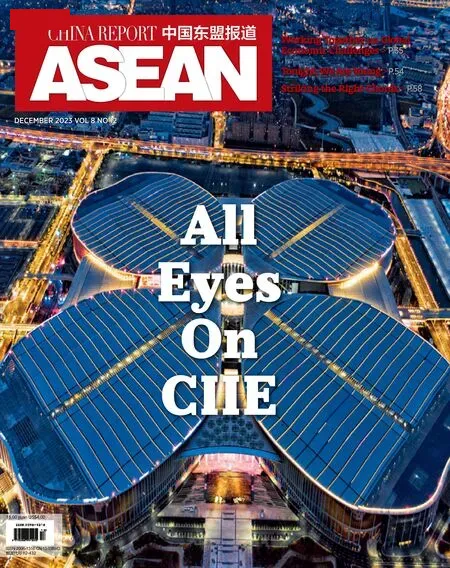A Platform for Global Trade Cooperation
By Chen Ke
CIIE has tapped considerable potential for developing countries to export value-added products to China
“In a changing trade landscape,the CIIE testifies to the fact that China continues to be open to importing products,services,and investment from around the world—including from small businesses in developing countries,” said Pamela Coke-Hamilton,executive director of the International Trade Center (ITC),in an exclusive interview with China Report ASEAN at the opening ceremony of the sixth CIIE in Shanghai.
The ITC is an international organization created by the General Agreement on Tariffs and Trade (GATT)in Geneva in March 1964 that has been operating under the joint aegis of the GATT and the United Nations Conference on Trade and Development (UNCTAD)since 1968.
Coke-Hamilton visited China to attend the sixth CIIE and the Hongqiao International Economic Forum.She shared her views on international economic and trade cooperation at several sub-forums.
Trade-led Development Opportunities
This was Coke-Hamilton’s first time to attend the CIIE in person.She dubbed the CIIE an important platform for trade for two key reasons: First,imports are as important as exports for tradeled growth;second,South-South trade and investment are key to shaping a more inclusive and sustainable future,including for the least developed countries (LDCs).
Coke-Hamilton explained that the CIIE is unique in the sense that it focuses on imports,contrasting trade fairs which usually promote exports.Hosting an import fair at this scale—already the largest in the world—has sent a signal that China is open to more products,services,and investment from around the world as well as trade-led development opportunities.
She said that in an interconnected world in which trade in intermediate goods still accounts for half of global trade,imports are often crucial components to produce final products and services despite recent declines due to supply chain disruptions.
On South-South trade,Coke-Hamilton thinks that China,as the world’s secondlargest importer and consumer,has a major role to play in promoting South-South trade,including through the CIIE.
“There are two reasons for that,” she said.“First,China has already been among the top destinations for exports from the LDCs since 2008,receiving more than a quarter of all the LDC merchandise exports in 2021,making it an attractive market for these countries and providing significant opportunities for their economic growth through trade,especially in times of global uncertainty.Second,doing business with Chinese importers will help small businesses from developing countries build overall resilience and reduce the risk of supply chain disruptions by creating larger,more diversified networks of buyers for them,decreasing reliance on one or two key partners.”
Facilitating Participation of Small Enterprises
As of last March,46 countries had been listed by the United Nations as LDCs.A total of 16 LDCs participated in country exhibitions at the sixth CIIE,and companies from 29 LDCs participated in business exhibitions.The CIIE has helped specialty products from those countries enter the Chinese market by offering them free booths and providing subsidies,preferential tax policy for the retention and purchase of exhibits,and other incentives.Statistics show that the previous five CIIEs attracted enterprises from 43 LDCs.
Coke-Hamilton noted that the ITC has been the official partner of the CIIE since 2019.“This year,we brought 65 companies in agriculture/food,consumer goods,and services sectors from across Africa,Asia,Latin America and the Caribbean,Europe,and the Middle East.”

Visitors taste wine from Georgia in the food and agricultural products exhibition area of the sixth CIIE in Shanghai on November 7,2023.(IC PHOTO)
From her perspective,empowering small businesses from developing countries to radiate such presence at the largest import fair in the world is meaningful.The message is that small players have a key role to play in international trade,whether it is input,value-added goods,or services.By being physically present,they can directly connect with buyers,which eliminates a key challenge: access to buyers and markets.
“During the fifth CIIE,for example,a Rwandan company sold 17 tons of dried chilies to a Chinese buyer,who received the products at a warehouse in Shanghai the very same evening,”Coke-Hamilton said.“This is not only about making business deals,but about small businesses expanding their global business networks—which we found is a key factor to building overall resilience—and exploring opportunities for skills training and technology transfer within the context of those deals.”
More Inclusive and Resilient Trading System
In October,shortly before the sixth CIIE,the third Belt and Road Forum for International Cooperation (BRF)took place in Beijing.Coke-Hamilton said that since the Belt and Road Initiative (BRI) was launched a decade ago,the world has drastically changed.“We’ve seen conflict and geopolitical tensions,debt and inflation burdens,opportunities,and challenges arise from climate change and the rapid rise of digital technology during the pandemic,” she added.
She pointed out that the BRI has adapted with the times.“At the latest BRF,we saw an overall shift in focus from big-ticket infrastructure projects like railroads,ports,and airports to greener and more high-tech initiatives such as digital connectivity and the development of e-commerce platforms,” she said.“The future of trade is green and connected,so this is a move in the right direction.”
“In addition to opportunities emerging from green and digital trade,developing countries can look at opportunities in value-added trade,” she continued.“Our latest report shows that there is strong export potential for valueadded goods from developing countries to China.” She announced that the ITC would release its latest research report Exporting to China: Opportunities for developing countries in the Belt and Road Initiative at this CIIE.She revealed that the numbers indicate that developing countries have great potential to export value-added products to China.
“While concentrated in Asia,all regions have major opportunities for manufacturing export growth to China in metal-based products (precious,ferrous and others) and other resourcebased sectors (such as wood and paper products),but opportunities have also emerged in less traditional sectors such as motor vehicles and parts,machinery and electricity,and chemicals,” she said.“Our results show that exports from developing countries to China could increase by up to US$318 billion by 2027.Speaking broadly,it will be important to ensure the benefits of trade extend to as many people as possible—in China and outside of China—to help create a more inclusive and resilient trading system.”

